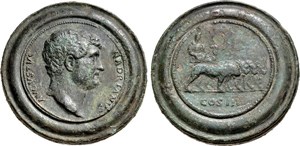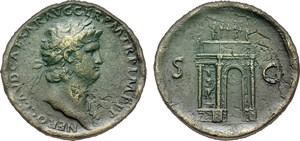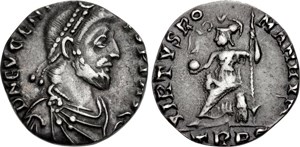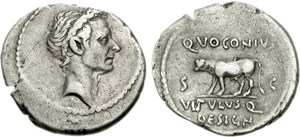NGC Ancients: The Third Side of the Coin
Posted on 5/12/2015
At NGC Ancients we examine the “third side” of all ancient coins. Though the edge bears no designs original to the coin, viewing it is an important aspect of the evaluation process for a number of reasons, from the determination of authenticity to helping better define market value.
 |
|
| This medallion of the Roman Emperor Hadrian (A.D. 117 to 138) survives mounted in an ancient frame. Click image to enlarge. |
|
 |
|
| This gold aureus of the Roman Emperor Gordian III (A.D. 238 to 244) was used for jewelry in ancient times. Click image to enlarge. |
|
Some counterfeits of ancient coins appear convincing if only the obverse and reverse are viewed, yet their true nature is revealed when the edge is examined. If the counterfeit is cast, the edge may have a seam or the remnant of a casting channel. Also, when recognizing an electrotype, the edge is the most important place to look.
Those who strike modern forgeries of ancient coins often make critical mistakes with edge characteristics, which can be among the most difficult features to replicate. Not all edges of ancient coins are similar in appearance and what is correct for one coin type may be inappropriate for another.
Counterfeit detection aside, we must consider the importance of the edge in the evaluation of condition. Because it has no design, the edge is often overlooked, yet it can reveal much about the history and use – or abuse – of a coin.
Typically, the edge of an ancient coin is free of major impairment, but in some cases it has been subjected to damage or alteration. We may best reflect upon this subject by thinking of the damage in terms of being ancient or modern, and as incidental or purposeful.
If edge damage is ancient it may actually add interest to a coin. For example, if the edges were hammered, notched or filed to transform a coin into an object with a different function (such as a counter or a weight) the collector interest in that item might well be increased.
Some Roman bronze coins had their edges hammered to create a category of object now called a “proto-contorniate”. If the coin is in extraordinary condition, the hammering likely has reduced the value of the item in comparison to an unaffected piece in the same condition. However, if the coin is worn, the hammering likely will have increased its level of interest and value.
 |
| The edge of this sestertius of the Roman Emperor Nero (A.D. 54-68) was hammered in ancient times into “proto-contorniate” form. Click image to enlarge. |
Most forms of damage to a coin’s edge, however, simply detract from value. For example, a deep crack on a coin’s edge sometimes was “closed” with a heavy hammer blow. This occurs with some frequency on Roman sestertii of the 2nd Century A.D. and results in a raised, pinched edge that many collectors find unappealing (even if – presumably – the hammering was performed at the mint).
Edge hammering also occurs on some electrum coins, notably staters of the kings of the Bosporus, and third-staters (trites) of Lydian kings from the late 7th through mid-6th Centuries B.C. However, the visible effects of hammering in these cases are minimal, and they rarely affect collector value one way or another.
Many gold and silver coins of the Roman and Byzantine empires had their edges clipped or filed by some ancient entrepreneur to remove metal. This happened most often with thin coins struck from the 4th Century A.D. onward. Silver was clipped most often in the western areas of Europe, and gold more often was clipped in the eastern territories of those empires.
 |
|
| The edge of this silver siliqua of the Roman usurper Eugenius (A.D. 392 to 394) was clipped during its period of circulation. Click image to enlarge. |
|
Edges may have been filed for a host of other reasons, too. In ancient times (as now) efforts may have been made to alter the shape of a coin so that it fit into a bezel. Sometimes ancient coins are unearthed while still in a bezel; other times we can presume by the nature and location of edge marks that the coin had been mounted in jewelry, be it in ancient or modern times.
Other times, a mount was soldered to the edge of a coin. If the mount had broken off or was removed, a trace of the damage will remain. Often an effort has been made to disguise or minimize the traces of such damage. This qualifies as a repair, and it is always our intention to describe it as such.
We also note that the purity of coins sometimes was tested in ancient times. The most common forms of such testing were test cuts, banker’s marks or countermarks. Though most marks were applied to determine if a coin was a plated counterfeit, some efforts were made with other functions in mind, such as confirming the value and/or acceptability of ancient coins.
 |
|
| The edge of this silver denarius portraying the deified Julius Caesar (d.44 B.C.) was test-cut in ancient times. Click image to enlarge. |
|
In the final analysis, each collector must determine how edge damage affects their level of interest in an ancient coin. If the damage is minimal or for some reason is of historical value, it might not be a deterrent at all, whereas if the damage is extensive, some collectors might want to avoid such coins all together. For others, the presence of edge damage might spell opportunity: if the value of a coin is significantly reduced by the damage, a motivated collector might want to acquire that coin since a damage-free example might be beyond financial reach.
Interested in reading more articles on Ancient coins? Click here
Images courtesy of Classical Numismatic Group, Inc.
Stay Informed
Want news like this delivered to your inbox once a month? Subscribe to the free NGC eNewsletter today!
